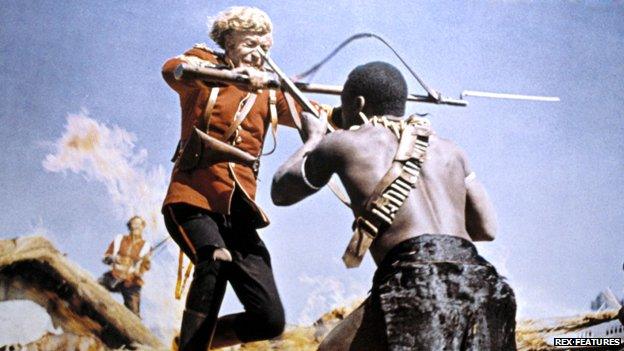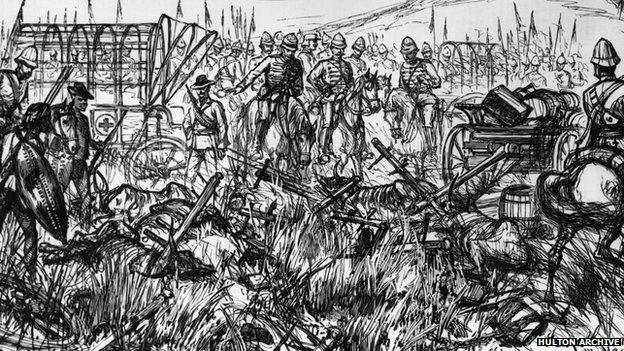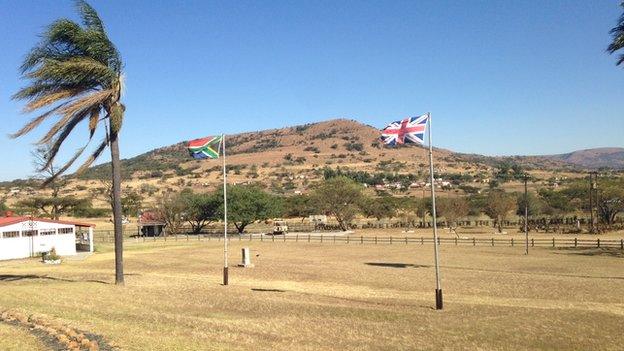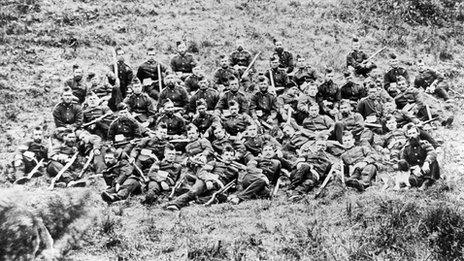Zulu - the film which inspired UK and South Africa
- Published

Zulu was Michael Caine's first major film
At the foot of a steep hillside lined with dry grass and littered with grey-brown boulders, Alistair Lamont was trying his best to imitate the sound of 4,000 Zulu warriors approaching over the ridge.
"Mzeeeeee," said Mr Lamont, in a gruff baritone, before confidently declaring that "was the sound that Michael Caine heard".
History and cinema have a habit of getting mixed up here at Rorke's Drift - a small village deep in the spectacular hills and gullies of South Africa's KwaZulu-Natal province.
Historians may be right in asserting that 22 January 1879 was the date that put Rorke's Drift on the map.
But how many of us would have remembered the ferocious battle that took place that afternoon, and the long night that followed, had it not been for Zulu - the vivid 1964 film that starred a young Michael Caine and is now celebrating its 50th anniversary?
"It's a film about men behaving bravely," said Mr Lamont - a local tour guide - who acknowledged that most tourists who made the long trek here were drawn by a movie that "captures the sounds and the spirit this battle was fought in - with the bravery of men on both the British and Zulu sides.
"Indeed an unmatched 11 Victoria Crosses were awarded to some of the successful defenders of the small outpost," added Mr Lamont.
"I've seen the film a few times. My dad's obsessed with it," said a visiting British tourist, Paul Holcroft, last week.
"It's the fact that so few British soldiers held off such a large number [of Zulus] - 139 against 4,000," he said.
Tens of thousands of people - many from Britain - visit both Rorke's Drift and the nearby (and militarily far more important) battlefield of Isandlwana each year, to be guided through the history of the 1879 Anglo-Zulu war by Mr Lamont and his colleagues.

The Anglo-Zulu war

Lasted from 22 January 1879 until 4 July
The battle of Isandlwana was the only major battle in colonial history in which the British were defeated by an African army - the Zulus led by King Cetshwayo
Later that day, fighting began in nearby Rorke's Drift, with 139 British soldiers holding off some 4,000 Zulus
British reinforcements arrived the following day by which time the defeated Zulu forces had already gone, leaving their dead and wounded behind
The Zulus continued to resist until July, when the royal palace in Ulundi was captured
British victory paved the way for takeover of South Africa's rich gold and diamond mines and the country's incorporation into the British Empire

Royal film star
The experience was pioneered by South African historian David Rattray, who was murdered during a robbery at his nearby home in 2007, and whose charitable trust now stands to benefit, along with Prince Harry's Sentabale charity and Walking with the Wounded, from the re-release of Zulu.
The film - digitally re-mastered - is having an anniversary premiere screening in London this Tuesday.
"Michael Caine was a very shy young man. Not as outgoing as he probably is today," chuckled Mangosuthu Buthelezi, 85, watching Zulu on a laptop in Durban and reminiscing about his own unexpected role in the film.

The site has become a major tourist attraction
Mr Buthelezi said the film's producers had come to visit him in 1963 to discuss hiring extras, but had suddenly offered him a role, playing his own great-grandfather, the Zulu King Cetshwayo - a key figure in the war.
"There was some hesitancy on my part. I didn't know if it would have political implications," he said.
But although the film was shot on location in the nearby Drakensberg mountain range at the height of racial apartheid, the set itself was "an oasis".
"In a sense we forgot we were in this country at the time. Whites and blacks could mingle without any fuss. You might say it was a very small thing but for this country, which was so racist at the time, it was something of great significance for us," said Mr Buthelezi.
"The film helped restore to pride about where we come from - about how our people resisted the mightiest army in the world at the time, even though we were poorly equipped with cow-hide shields and spears," he said.

The battle was re-enacted on its 125th anniversary, in 2004
That sense of pride is echoed by Mondli Makanya - a South African journalist, a Zulu, and a board member of the David Rattray Foundation.
"I saw the film as a child. It was the time of Rambo," he said, remembering the thrill of watching black South Africans on screen in Zulu during the apartheid era.
"On that film you actually saw people who looked like you being triumphant. That's my memory of that movie - seeing heroes who looked and behaved like me," said Mr Makanya.
But he acknowledged that the film is little known in South African these days.
"It would be a great thing right now to have some screenings here… because it's about a great South African moment - a moment everyone is still very attached to, and so for it to have more currency in the United Kingdom than in South Africa is a great tragedy," he said.
- Published25 February 2012
